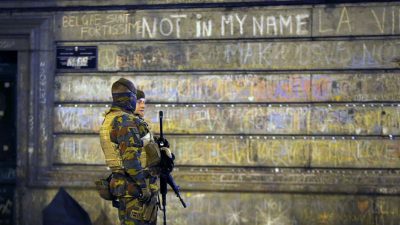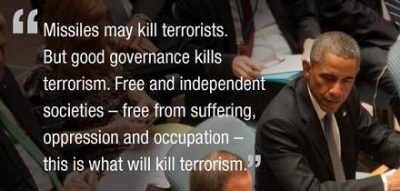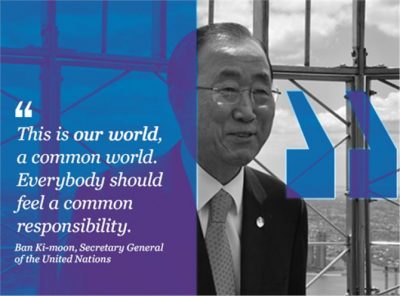Francois Lenoir/Reuters
By
Cynthia M. Lardner
The fight against violent extremism is being fought by a shift in global consciousness resulting in a collective effort by governments, NGOs and stakeholders, including individuals at the local level. Radicalized extremism, which has nothing to do with religion, is an ideology founded on inducing fear of imagined or future danger. It is a feeling, not an action. Simply stated, extremism is psychological warfare.
The effectiveness of any extremist act is not the act itself, but the extent of the fear evoked in the general public. The public’s apperception of fear is a miscalculation as the attack has already occurred and the likelihood of being personally involved in a future attack is less than negligible. In turn, we subconsciously transfer our fear to the Muslim population giving rise to widespread bigotry and hatred. We have permitted the real battleground to be a mental schema that we have been conditioned to experience for more than fifteen years.
What are we so afraid of?
The U.S. Department of State defines extremism as “…premeditated politically-motivated violence perpetrated against non-combatant targets by sub-national groups or clandestine agents, usually intended to influence an audience.”
Violent attacks are staged by radicalized extremists to maximize publicity. For instance, attacks are often scheduled for Friday mornings triggering a seemingly nonstop barrage of sensationalized weekend media reports.
Targets are chosen to not only symbolize what extremists oppose but, also those which will generate the most media coverage and public sympathy. Sympathy was the motive behind the November 13, 2015 Paris attack on a nightclub frequented by young people and at an international sporting event, and the June 12, 2015 attack on a gay bar was in Orlando, America’s favorite family destination. Recent examples of acts based on opposition were the March 22, 2016 Brussels attacks, which came days after the Belgium arrest of the last known suspect in the Paris attack, and the January 7, 2015 Paris Charlie Hebdo attack in objection to its re-publication of the Jyllands-Posten cartoons of Muhammad.
Other more random attacks are undertaken by individuals with no identifiable nexus to extremist leaders even though the attackers claim allegiance to the ideology, as was the case in the December 2, 2015 San Bernardino shooting.
Regardless of the motive, the result is “An anxiety-inspiring method of repeated violent action, employed by (semi-) clandestine individuals, group or state actors, for idiosyncratic, criminal or political reasons, whereby – in contrast to assassination – the direct targets of violence are not the main targets”; the United Nations’ 1992 definition.
The target is you, the general public.
By the Numbers
The chance of a Westerner being killed by a violent extremist act is exceedingly low: about a one in three million chance each year.
Between 9/11 and 2013, foreign-inspired violent acts of extremism only claimed two dozen lives in the United States. Globally, the U.S. Department of State reported that, in 2011, only 17 U.S. civilians were killed worldwide by extremists, including deaths in all theaters of war.
The 2011 Report on Terrorism from the National Counterterrorism Center stated that Americans are as likely to be “crushed to death by their televisions or furniture each year” as they are to be killed by an extremist. As one Washington Post headline read, “You’re more likely to be fatally crushed by furniture than killed by a terrorist”.
Abandoning the Schema
In a recent statement, President Barack Obama stated:
“Groups like ISIL and al-Qaida want to make this war a war between Islam and America, or between Islam and the West. If we fall into the trap of painting all Muslims as a broad brush, and imply that we are at war with the entire religion, then we are doing the terrorists’ work for them.
But we are now seeing how dangerous this kind of mind-set and this kind of thinking can be. We are starting to see where this kind of rhetoric and loose talk and sloppiness about who exactly we are fighting, where this can lead us. This is a country founded on basic freedoms, including freedom of religion. We don’t have religious tests here. Our founders, our Constitution, our Bill of Rights are clear about that.
And if we ever abandon those values, we wouldn’t only make it a lot easier to radicalize people here and around the world, but we would have betrayed the very things we are trying to protect, the pluralism and the openness, our rule of law, our civil liberties, the very things that make this country great, the very things that make us exceptional.
And then the terrorists would have won. And we cannot let that happen.”
How, Why and Where Radicalization Transpires
According to John Horgan, PhD, Director the Pennsylvania State University’s International Center for the Study of Terrorism, people who are predisposed to extremist recruitment and radicalization tend to:
-
Feel angry, alienated or disenfranchised;
-
Believe that their current political involvement does not give them the power to effect real change;
-
Identify with perceived victims of the social injustice they are fighting;
-
Feel the need to take action rather than just talking about the problem;
-
Believe that engaging in violence against the state is not immoral;
-
Have friends or family sympathetic to the cause; and
-
Believe that joining a movement offers social and psychological rewards such as adventure, camaraderie and a heightened sense of identity.
Mosques Are Not Enclaves for Terrorists
Loners by nature, “More than 80 per cent who join the Islamic State do so through peer-to-peer relationships, mostly with friends and sometimes family. Very few join in mosques or through recruitment by anonymous strangers… radicalization rarely occurs in mosques,” stated Scott Atran, co-founder of the Center for the Resolution of Intractable Conflict at Oxford University.
Charles Kurzman, a professor of sociology at the University of North Carolina at Chapel Hill, co-author of a 2010 report “Anti-Terror Lessons of Muslim-Americans”, also found that, “Very few of these [extremist] individuals are regular participants at American mosques. In fact, in a number of cases they have expressed hostility toward their local religious leaders. Unfortunately, it seems to be a pattern that these individuals engaged in violent extremism move away from the mosque as they become radicalized and are interacting less with the religious leaders who preach peace.”
The Islamic Community
The American-Muslim community has publicly and privately denounced terrorism and violence, is willing to report radical individuals to law enforcement, and encourages community building and political engagement.
A 2010 study conducted by Duke University and the University of North Carolina at Chapel Hill determined that these programs are an effective deterrent to radicalization. That study also found that “48 of the 120 Muslims suspected of plotting domestic terrorist attacks since Sept. 11, 2001, were turned in by fellow Muslims, including parents, mosque members and even a Facebook friend.”
Mosques around the world have created programs to engage vulnerable youth to prevent radicalization by the rampant extremist propaganda, easily accessed on social media. Countering radicalization has been a topic in sermons and at national conferences.
When ISIS emerged, the world’s most prominent Muslim leaders and scholars published an open leader to ISIS leader Abu Bakr al-Baghdadi renouncing the militant group’s religious claims, including that of the Caliphate.
Yet, despite its best efforts, the Muslim community is so stigmatized that after the Paris attack the hashtag #NotInMyName emerged on social media.
The Media’s Role
First and foremost, the media’s disproportionate focus on Western acts of terror reinforces such mistaken perceptions. “Extremely vivid image[s] of death and damage” resulting from terrorist attacks are “reinforced by media attention and frequent conversation,” leaving us with highly accessible memories of such events, stated Daniel Kahneman, Professor Emeritus at Princeton University.
For instance, CNN International, six days after the Orlando shooting, was still displaying the headline “Terror in Orlando”, fostering the apperception that there exists cause for fear of another and imminent attack.
“When people who have been exposed to such coverage later assess how likely more terrorism is, such events come readily to mind — and so they are likely to assign probabilities biased upward,” stated former Pentagon official Andrew Shaver.
Second, by engaging in nonstop and repetitive reporting the media is acting as a de facto public relations department for extremist organizations. Media must shift its focus from repeatedly showing videos of attacks to the courage and solidarity exhibited by first responders, the community, surviving family and friends, and committed law enforcement officials.
Consider that just one additional New York Times article about an attack in any country increased the probability of ensuing attacks in that country by between 11% and 15%. On average, that additional NYT article results in between one and two casualties from another attack within the next week.
Fourth, the question is always posed of a government official or expert, “What could the government have done to prevent this attack?” After a brief pause, the interviewee utters something vague.
Take for example the attack on the Brussels airport. Over and over again, reporters asked officials what they could have been done to prevent the attack. One “expert” opined that security should have been moved outside of the building. The reality is that all this would have accomplished is moving the queue to another location. The correct answer is there was probably nothing that could have been done to prevent that attack.
With an increasing number of “homegrown” extremists, there is even less intelligence available to thwart attacks.
Yet, for days after, an attack line of questioning continues when the focus in the aftermath ought to be on the inherent strength and resiliency of Western communities and the good work done by law enforcement officials.
Fifth, the word choices made by the news and entertainment industries are often inflammatory. For instance, the term “suicide bomber” is almost always used as opposed to the more accurate term “homicidal extremist”. Continuous headlines such as “Terror in Orlando”, rather than “Solidarity in the Midst of Tragedy” or “Law Enforcement Responded With Flying Colors”, not only sends the wrong message to the public but furthers extremist objectives.
Sixth, oftentimes, the reporting is inaccurate. For instance, after the November 2015 Paris attack, CNN’s Wolf Blitzer reported that the “Caliphate” was responsible. ISIS’ claim that its leader is the Caliphate, or a prophet sent by God to provide just governance for all of Islam, could not be farther from the truth. But, given Mr. Blitzer’s credibility, the public readily believe what he says.
To successfully combat violent extremism, responsible journalism is essential.
Donald Trump is Even More Culpable
As the presumptive Republican presidential candidate, Donald Trump ought to be upholding the principles so carefully articulated by the United States’ founding fathers in the Constitution. Rather, he actively promotes hatred and bigotry giving rise to violent and large protests at his public appearances.
Oddly, political commentators seem to have no knowledge of the Fighting Words Doctrine, which the United States Supreme Court in 1942 held to be a limitation that freedom of speech protected by the First Amendment. In a unanimous decision, Chaplinsky v. New Hampshire, the High Court held that “insulting or ‘fighting words,’ are those that by their very utterance inflict injury or tend to incite an immediate breach of the peace”. Can there be any doubt that Mr. Trump’s remarks rise to the level of fighting words?
On Monday, June 13, 2016, Mr. Trump added to the plethora of anti-Muslim statements when he promised that, if elected, he would “suspend immigration from areas of the world when there is a proven history of terrorism against the United States, Europe or our allies, until we understand how to end these threats.” Perhaps Mr. Trump should learn about the International Declaration of Human Rights, the Geneva Conventions and the Convention and Protocol Related to the Status of Refugees, which grants individuals the right, under international law, to seek political asylum.
Mr. Trump further stated that, if president, he would insure that mosques were monitored. Apparently, he has not read the research. In the wake of 9/11, after more than six years of spying on Muslim neighborhoods, eavesdropping on conversations and cataloguing mosques, the New York Police Department’s secret Demographics Unit never generated a lead or triggered a terrorism investigation.
As President Obama stated, “We now have proposals from the presumptive Republican nominee for president of the United States to bar all Muslims from immigrating into America. We hear language that singles out immigrants and suggests entire religious communities are complacent in violence.”
Combatting Violent Extremism
“Violent extremists are not a new threat; they have raged against civilization as long as we have tried to build it. What is new is how the United States and our partners around the world are pushing them back – with a more comprehensive, preventive, and civilian-centered approach we call Countering Violent Extremism, or CVE,” stated Sewall, Sarah, Unite States Under Secretary for Civilian Security, Democracy, and Human Rights.
As explained by The International Centre for Counter-Terrorism – The Hague, “CVE programmes include an astonishing range of activities, from messaging to community outreach, to religious argumentation, to economic development. Programmes proposed under the rubric of CVE can range from individual interventions to efforts to rewrite the script for entire societies, from the economy to social mores.”
Richard Stengel, U.S. Under Secretary of State for Public Diplomacy and Public Affairs, stated that efforts against extremism should focus “not only countering their message, but creating a positive alternative for people who may be attracted to their message”.
Thus, CVE has two overlapping goals:
-
Disengagement to dissuade individuals from violent participation in and material support for violent extremist organisations and movements.
-
De-radicalization/counter-radicalization to dissuade individuals from adopting extremist ideologies.
The global movement behind these goals includes the RESOLVE network brought about in February 2014 at the White House Summit on Countering Violent Extremism, which launched a comprehensive CVE effort that now encompasses over 100 countries, 20 multilateral bodies, and 400 civil society organizations.
As a result, foreign governments are developing CVE strategies providing meaningful roles for those outside government.
According to Ms. Sewall, “Many of those actors – like young people, mayors, and women – have launched their own global networks to learn from each other’s experience countering violent extremism in their communities.”
What Can You Do?
Get involved at the local level with CVE initiatives. A list of resources can be accessed here.
Write to the media to express your concerns, refuse to watch inflammatory programming, have the self-control to know when “enough is enough” and the wisdom to understand what is real and what is fiction.
For those of us in the European Union and the United States, we must exercise our right to vote for politicians who respect national and international law, and who promote harmonious and peaceful relationships among diverse populations and governments.
Write or petition school and government officials to offer compulsory education. “Without anti-racism education, war will continue to prevail and peace will continue to be what it is; a falsehood that distracts the world populace from the reality on the ground… Otherwise, we will continue to have the rise of terrorist states,” stated Ahmad Moussa, a Palestinian-Canadian professor and author.
Participate in global interfaith activities to learn more about not just the Islamic faith but, other faiths that differ from your own. Most people are unaware that the three major world religions, Christianity, Judaism and Islam all share a common belief in Jesus.
We can open our minds and hearts to the moderate Muslim populations in our communities. For instance, many mosques and Islamic community centers host programs that are open to the general public. Attending events will reduce conditioned fear.
We should also be diligent in reporting activity that we feel is suspicious. It’s better to be safe than sorry.
The bottom line is that we can all participate in the war on extremism.
“The only way to change the world is to change the story,” stated Llewellyn Vaughan-Lee, Sufi teacher and scholar.
Cynthia M. Lardner
Cynthia M. Lardner is a journalist focusing on geopolitics. Ms. Lardner is a contributing editor for Tuck Magazine and E – The Magazine for Today’s Executive Female Executive, and her blogs are read in over 37 countries. As a thought leader in the area of foreign policy, her philosophy is to collectively influence conscious global thinking. Ms. Lardner holds degrees in journalism, law, and counseling psychology.





Great article, talking sense about the threat of terrorism. You have backed up your essay with scholarly sources, and verified your conclusions. I would only add that we need to acknowledge the growing menace of terrorism from the ultra-right. The following is an article I wrote back in April 2015: We remember the Boston marathon bombing - but do not forget what happened at Oklahoma City https://rupensavoulian.wordpress.com/2015/04/03/we-remember-the-boston-marathon-bombing-but-do-not-forget-what-happened-at-oklahoma-city/ Cheers from Sydney Rupen Savoulian.